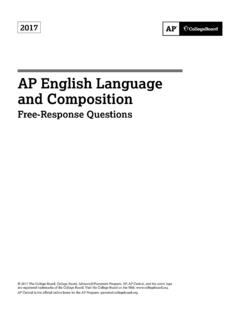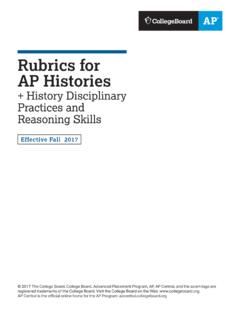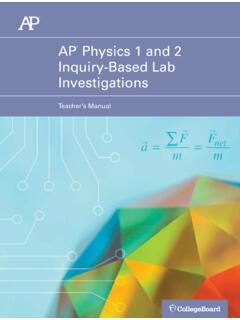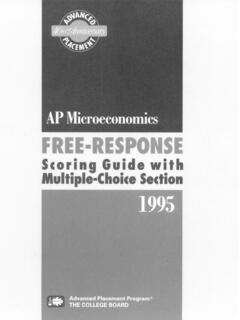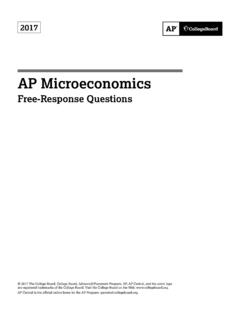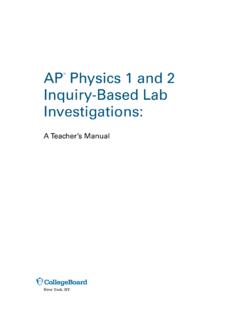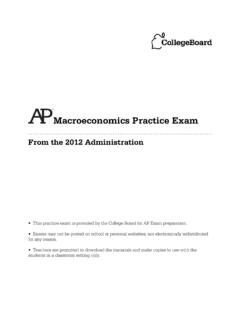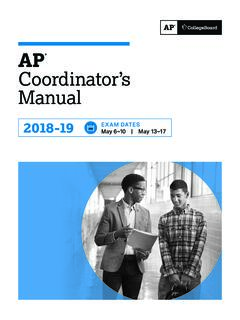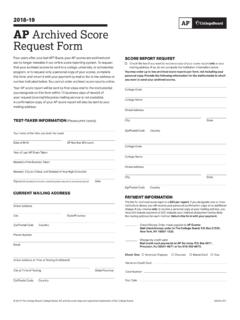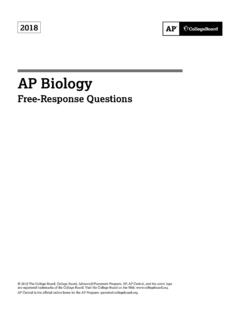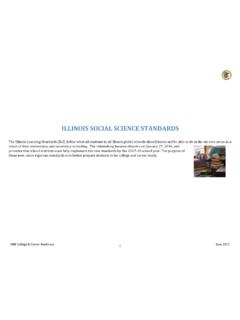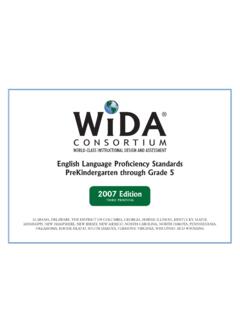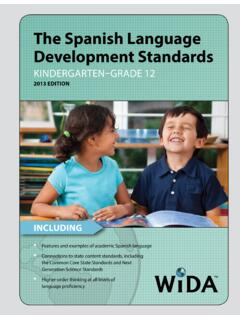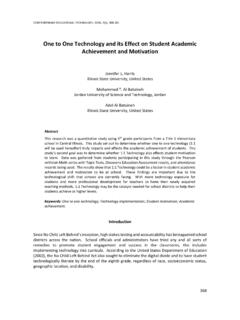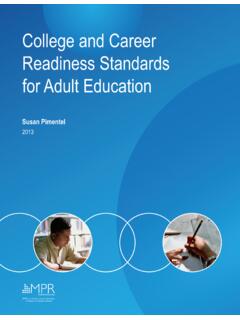Transcription of 2017 AP Computer Science Principles - The College Board
1 AP Computer Science PrinciplesCOURSE AND EXAM DESCRIPTIONE ffective Fall 2020 INCLUDES Course framework Instructional section Sample exam questions Create performance task guidelinesAP COURSE AND EXAM DESCRIPTIONS ARE UPDATED PERIODICALLYP lease visit AP Central ( ) to determine whether a more recent course and exam description is Computer Science PrinciplesCOURSE AND EXAM DESCRIPTIONE ffective Fall 2020 About College Board College Board is a mission-driven, not-for-profit organization that connects students to College success and opportunity. Founded in 1900, College Board was created to expand access to higher education. Today, the membership association is made up of more than 6,000 of the world s leading educational institutions and is dedicated to promoting excellence and equity in education. Each year, College Board helps more than seven million students prepare for a successful transition to College through programs and services in College readiness and College success including the SAT and the Advanced Placement Program.
2 The organization also serves the education community through research and advocacy on behalf of students, educators, and further information, visit Equity and Access PolicyCollege Board strongly encourages educators to make equitable access a guiding principle for their AP programs by giving all willing and academically prepared students the opportunity to participate in AP. We encourage the elimination of barriers that restrict access to AP for students from ethnic, racial, and socioeconomic groups that have been traditionally underrepresented. Schools should make every effort to ensure that their AP classes reflect the diversity of their student population. College Board also believes that all students should have access to academically challenging coursework before they enroll in AP classes, which can prepare them for AP success. It is only through a commitment to equitable preparation and access that true equity and excellence can be : Sonny Mui and Bill Tully 2020 College Board .
3 College Board , Advanced Placement, AP, AP Central, and the acorn logo are registered trademarks of College Board . All other products and services may be trademarks of their respective College Board on the web: v Acknowledgments 1 About AP 4 AP Resources and Supports 6 Instructional Model7 About the AP Computer Science Principles Course 7 College Course Equivalent 7 PrerequisitesCOURSE FRAMEWORK 11 Introduction 13 Course Framework Components 15 Computational Thinking Practices 17 Course Content 20 Course at a Glance 23 Big Idea Guides 24 Using the Big Idea Guides 27 BIG IDEA 1: Creative Development 41 BIG IDEA 2: Data 57 BIG IDEA 3: Algorithms and Programming 97 BIG IDEA 4: Computer Systems and Networks 109 BIG IDEA 5: Impact of ComputingINSTRUCTIONAL APPROACHES 129 Selecting and Using Course Materials 132 Instructional Strategies 140 Developing Computational Thinking Practices 152 Using Strategies for Collaboration 153 Differentiating Computer Science InstructionCURRICULUM ALIGNMENT 157 Curriculum Alignment 158 Unit at a GlanceEXAM INFORMATION 163 Exam Overview 172 Sample Exam QuestionsSTUDENT HANDOUTS 189 Create Performance Task 197 Guidelines for Completing the Create Performance TaskAPPENDIX 205 APPENDIX 1: AP CSP Exam Reference Sheet 213 APPENDIX 2.
4 AP CSP Conceptual FrameworkAcknowledgmentsIn partnership with the National Science Foundation, the AP Program collaborated with secondary and postsecondary educators and members of Computer Science education professional organizations to develop the AP Computer Science Principles course Board would like to acknowledge the contributors and reviewers for their assistance with and commitment to the development of this course. All individuals names and their affiliations were current at the time of Alvarado, University of California, San Diego, CABradley Bearden, Dadeville High School, Dadeville, ALJoseph Coglianese, Troy High School, Fullerton, CAAdam Cannon, Columbia University, New York, NYTom Cortina, Carnegie Mellon University, Pittsburgh, PASandy Czajka, Riverside Brookfield High School, Riverside, IL Marilyn Fitzpatrick, Charles H. Flowers High School, Springdale, MDDan Garcia, University of California, Berkeley, CA Jessica Jarboe, Milton High School, Milton, MADouglas Kiang, Punahou High School, Honolulu, HI Jennifer Rosato, The College of St.
5 Scholastica, Duluth, MNAlexander Schenk, Collegiate School of Medicine and Bioscience, St. Louis, MOPaul Tymann, Rochester Institute of Technology, Rochester, NYChinma Uche, CREC Academy of Aerospace and Engineering, Windsor, CTJill Westerlund, Hoover High School, Hoover, ALCarol Yarbrough, Alabama School of Fine Arts, Birmingham, ALCollege Board StaffBecky Coutts, Director, AP Computer Science A Content DevelopmentCrystal Furman, Director, AP Computer Science Principles Content DevelopmentDana Kopelman, Executive Director, AP Instructional ProductsClaire Lorenz, Senior Director, AP Instructional ProductsDaniel McDonough, Senior Director, AP Content and Assessment PublicationsAllison Milverton, Director, AP Curricular PublicationsMaureen Reyes, Executive Director, AP Program ManagementAllison Thurber, Executive Director, AP Curriculum and AssessmentCarol Whang, Senior Project Manager, AP Program ManagementSPECIAL THANKS Jan Cuny, Owen Astrachan, Amy Briggs.
6 And the National Science Foundation Return to Table of Contents 2020 College BoardAP Computer Science Principles Course and Exam Description | vTHIS PAGE IS INTENTIONALLY LEFT APCollege Board s Advanced Placement Program (AP ) enables willing and academically prepared students to pursue College -level studies with the opportunity to earn College credit, advanced placement, or both while still in high school. Through AP courses in 38 subjects, each culminating in a challenging exam, students learn to think critically, construct solid arguments, and see many sides of an issue skills that prepare them for College and beyond. Taking AP courses demonstrates to College admission officers that students have sought the most challenging curriculum available to them, and research indicates that students who score a 3 or higher on an AP Exam typically experience greater academic success in College and are more likely to earn a College degree than non-AP students.
7 Each AP teacher s syllabus is evaluated and approved by faculty from some of the nation s leading colleges and universities, and AP Exams are developed and scored by College faculty and experienced AP teachers. Most four-year colleges and universities in the United States grant credit, advanced placement, or both on the basis of successful AP Exam scores more than 3,300 institutions worldwide annually receive AP Course DevelopmentIn an ongoing effort to maintain alignment with best practices in College -level learning, AP courses and exams emphasize challenging, research-based curricula aligned with higher education can choose to adopt the curriculum of one of the AP endorsed providers or design their own curriculum for AP Computer Science Principles ,selecting appropriate College -level readings, assignments, and resources. This course and exam description presents the content and skills that are the focus of the corresponding College course and that appear on the AP Exam.
8 The intention of this publication is to respect teachers time and expertise by providing a roadmap that they can modify and adapt to their local priorities and preferences. By organizing the AP course content and skills into topics, the AP Program is able to provide teachers and students with formative Topic Questions that teachers can assign throughout the year to measure students progress as they acquire content knowledge and develop Students: Equity and AccessCollege Board strongly encourages educators to make equitable access a guiding principle for their AP programs by giving all willing and academically prepared students the opportunity to participate in AP. We encourage the elimination of barriers that restrict access to AP for students from ethnic, racial, and socioeconomic groups that have been traditionally underserved. College Board also believes that all students should have access to academically challenging coursework before they enroll in AP classes, which can prepare them for AP success.
9 It is only through a commitment to equitable preparation and access that true equity and excellence can be AP Courses: The AP Course AuditThe AP Program unequivocally supports the principle that each school implements its own curriculum that will enable students to develop the content understandings and skills described in the course AP Program does have a short list of curricular and resource requirements that must be fulfilled before a school can label a course Advanced Placement or AP. Schools wishing to offer AP courses must participate in the AP Course Audit, a process through which AP teachers course materials are reviewed by College faculty. Teachers can also adopt a syllabus from an AP endorsed provider during this AP Course Audit was created to provide teachers and administrators with clear guidelines on curricular and resource requirements for AP courses and to help colleges and universities validate courses marked AP on students transcripts.
10 This process ensures that AP teachers courses meet or exceed the curricular and resource expectations that College and secondary school faculty have established for College -level to Table of Contents 2020 College BoardAP Computer Science Principles Course and Exam Description | 1 The AP Course Audit form is submitted by the AP teacher and the school principal (or designated administrator) to confirm awareness and understanding of the curricular and resource requirements. A syllabus or course outline, detailing how course requirements are met, is submitted by the AP teacher for review by College visit for more information to support the preparation and submission of materials for the AP Course the AP Program Is DevelopedThe scope of content for an AP course and exam is derived from an analysis of syllabi and course offerings of colleges and universities. Using this research and data, a committee of College faculty and expert AP teachers work within the scope of the corresponding College course to articulate what students should know and be able to do upon the completion of the AP course.
